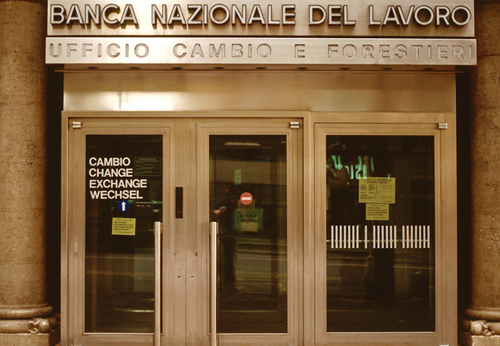Banking and Communications
Changing Money
Always change money at a bank (or, for American Express card-holders, at an Amex office) for the best rates and lowest commission charges. Bring your passport as ID. Exchange booths (cambio) are good at a pinch, but have worse rates and/or higher commission. Never exchange a travellers’ cheque (or use one to pay) at a shop or hotel unless you have to; the rates are awful.
Italian bank
Automated Teller Machines
The fastest, easiest and cheapest way to get local currency is via an ATM (bancomat), drawing money directly from your home account. No ID checks, no queues, and you get a better rate than inside the bank. Also no commission charge, unless your home bank charges you for out-of-network ATM use.
Credit Cards
MasterCard and Visa are accepted everywhere except the smallest shops, trattorie or hotels. American Express is also accepted in many places. Diner’s Club tends to be valid only at pricier places. You can get credit card cash advances from ATMs, but interest starts accruing immediately and both credit card companies and issuing banks charge small percentage fees for the service.
Travellers’ Cheques
While still the safest way to carry money (if you lose them and have kept a list of their numbers separate, you can have them speedily replaced), travellers’ cheques are doomed by the evolution of ATMs. A few cheques are good for emergencies, however. Buy them in dollars, pounds sterling or euros. Personal cheques are useless, unless you’re an Amex card-holder, in which case you can cash them at American Express offices.
Currency
In 2002, Italy joined most of Europe in adopting the euro (€) to replace the lira. Euro coins come in 1, 2, 5, 10, 20 and 50 euro cents and €1 and €2. Notes come in €5, €10, €20, €50, €100, €200 and €500 denominations.
Public Phones
Most payphones in Italy now accept only pre-paid phonecards (scheda telefonica) which you can buy in several denominations at newsstands and tobacconists (tabacchi). Break off the corner before use.
Calling Home
There are international phone booths in major railway stations and a range of pre-paid carta telefonica internazionale for making international calls, but the cheapest way is with a calling card with an international plan tied to your home phone account. To reverse the charges from any phone, dial the international operator on 170. Never call from hotels, which charge very high rates. To call Italy from abroad, dial your international prefix then Italy’s country code (39), then the number, including the zero.
Internet Access
Internet parlours and cafés are popping up constantly (ask at the tourist office; they tend to appear and disappear frequently). Increasingly, hotels are installing a common-use computer with web access.
Postal Services
Italy’s post can be slow – letters might arrive home in three days or three months. You don’t need to visit a post office (ufficio postale); just ask any tobacconist or newsagent for stamps (francobolli) for the country to which you are mailing. Then drop it in the slot of the postbox (usually red) labelled “per tutte le altre destinazioni”.
Receiving Mail
Mail addressed to you at “FERMO POSTA/ Piazza San Silvestro 19/ 00187 Roma, Italia/ ITALY” will make it to the main post office on Piazza San Silvestro. There’s a small fee to pick it up.
